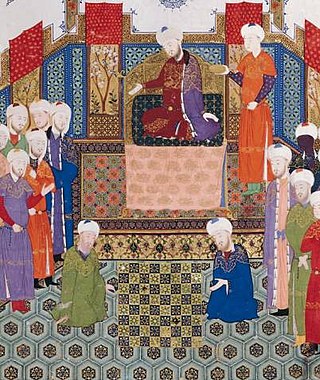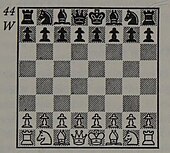
Algebraic notation is the standard method for recording and describing the moves in a game of chess. It is based on a system of coordinates to uniquely identify each square on the board. It is used by most books, magazines, and newspapers.

Shatranj is an old form of chess, as played in the Sasanian Empire. Its origins are in the Indian game of chaturaṅga. Modern chess gradually developed from this game, as it was introduced to Europe by contacts in Muslim Al-Andalus and in Sicily in the 10th century.

Alice chess is a chess variant invented in 1953 by V. R. Parton which employs two chessboards rather than one, and a slight alteration to the standard rules of chess. The game is named after the main character "Alice" in Lewis Carroll's work Through the Looking-Glass, where transport through the mirror into an alternative world is portrayed on the chessboards by the after-move transfer of chess pieces between boards A and B.
Stalemate is a situation in chess where the player whose turn it is to move is not in check and has no legal move. Stalemate results in a draw. During the endgame, stalemate is a resource that can enable the player with the inferior position to draw the game rather than lose. In more complex positions, stalemate is much rarer, usually taking the form of a swindle that succeeds only if the superior side is inattentive. Stalemate is also a common theme in endgame studies and other chess problems.

The pound sign is the symbol for the pound unit of sterling – the currency of the United Kingdom and its associated Crown Dependencies and British Overseas Territories and previously of Great Britain and of the Kingdom of England. The same symbol is used for other currencies called pound, such as the Egyptian and Syrian pounds. The sign may be drawn with one or two bars depending on personal preference, but the Bank of England has used the one-bar style exclusively on banknotes since 1975.
In linguistics and semiotics, a notation system is a system of graphics or symbols, characters and abbreviated expressions, used in artistic and scientific disciplines to represent technical facts and quantities by convention. Therefore, a notation is a collection of related symbols that are each given an arbitrary meaning, created to facilitate structured communication within a domain knowledge or field of study.

Checkmate is any game position in chess and other chess-like games in which a player's king is in check and there is no possible escape. Checkmating the opponent wins the game.

The Encyclopaedia of Chess Openings (ECO) is a reference work describing the state of opening theory in chess, originally published in five volumes from 1974 to 1979 by the Serbian company Šahovski Informator. It is currently undergoing its fifth edition. ECO may also refer to the opening classification system used by the encyclopedia.

Chess symbols are part of Unicode. Instead of using images, one can represent chess pieces by characters that are defined in the Unicode character set. This makes it possible to:
In chess, the fianchetto is a pattern of development wherein a bishop is developed to the second rank of the adjacent b- or g-file, the knight pawn having been moved one or two squares forward.

In chess, en passant describes the capture by a pawn of an enemy pawn on the same rank and an adjacent file that has just made an initial two-square advance. The capturing pawn moves to the square that the enemy pawn passed over, as if the enemy pawn had advanced only one square. The rule ensures that a pawn cannot use its two-square move to safely skip past an enemy pawn.
Chess notation systems are used to record either the moves made or the position of the pieces in a game of chess. Chess notation is used in chess literature, and by players keeping a record of an ongoing game. The earliest systems of notation used lengthy narratives to describe each move; these gradually evolved into more compact notation systems. Algebraic notation is now the accepted international standard, with several variants. Descriptive chess notation was used in English- and Spanish-language literature until the late 20th century, but is now obsolescent. Portable Game Notation (PGN) is a text file format based on English algebraic notation which can be processed by most chess software. Other notation systems include ICCF numeric notation, used for international correspondence chess, and systems for transmission using Morse code over telegraph or radio. The standard system for recording chess positions is Forsyth–Edwards Notation (FEN).
In chess and other related games, a double check is a check delivered by two pieces simultaneously. In chess notation, it is almost always represented the same way as a single check ("+"), but is sometimes symbolized by "++". This article uses "++" for double check and "#" for checkmate.
In chess, doubled pawns are two pawns of the same color residing on the same file. Pawns can become doubled only when one pawn captures onto a file on which another friendly pawn resides. In the diagram, the white pawns on the b-file and e-file are doubled. The pawns on the e-file are doubled and isolated.
When annotating chess games, commentators frequently use widely recognized annotation symbols. Question marks and exclamation points that denote a move as bad or good are ubiquitous in chess literature. Some publications intended for an international audience, such as the Chess Informant, have a wide range of additional symbols that transcend language barriers.
Segoe is a typeface, or family of fonts, that is best known for its use by Microsoft. The company uses Segoe in its online and printed marketing materials, including recent logos for a number of products. Additionally, the Segoe UI font sub-family is used by numerous Microsoft applications, and may be installed by applications. It was adopted as Microsoft's default operating system font beginning with Windows Vista, and is also used on Outlook.com, Microsoft's web-based email service. In August 2012, Microsoft unveiled its new corporate logo typeset in Segoe, replacing the logo it had used for the previous 25 years.
This article covers computer software designed to solve, or assist people in creating or solving, chess problems – puzzles in which pieces are laid out as in a game of chess, and may at times be based upon real games of chess that have been played and recorded, but whose aim is to challenge the problemist to find a solution to the posed situation, within the rules of chess, rather than to play games of chess from the beginning against an opponent.

The Staunton chess set is the standard style of chess pieces, recommended for use in competition by FIDE, the international chess governing body.

A floral diagram is a graphic representation of the structure of a flower. It shows the number of floral organs, their arrangement and fusion. Different parts of the flower are represented by their respective symbols. Floral diagrams are useful for flower identification or can help in understanding angiosperm evolution. They were introduced in the late 19th century and are generally attributed to A. W. Eichler.
The King's Fianchetto Opening or Benko's Opening is a chess opening characterized by the move:
















